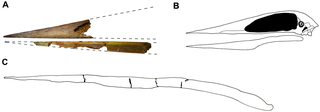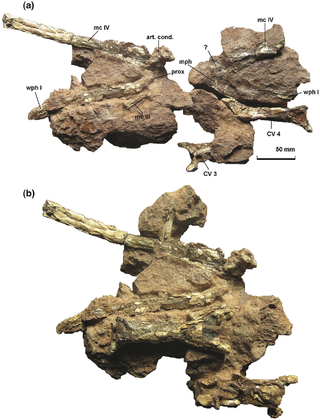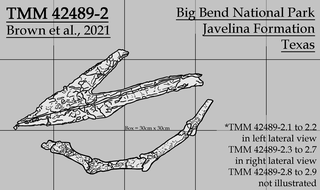
Quetzalcoatlus is a genus of azhdarchid pterosaur known from the Late Cretaceous Maastrichtian age of North America. Its name comes from the Aztec feathered serpent god Quetzalcoatl. The type species is Q. northropi, named by Douglas Lawson in 1975. The genus also includes the smaller species Q. lawsoni, which was known for many years as an unnamed species, before being named by Brian Andres and Wann Langston Jr. (posthumously) in 2021. Q. northropi has gained fame as a candidate for the largest flying animal ever discovered.

Azhdarchidae is a family of pterosaurs known primarily from the Late Cretaceous Period, though an isolated vertebra apparently from an azhdarchid is known from the Early Cretaceous as well. Azhdarchids are mainly known for including some of the largest flying animals discovered, but smaller cat-size members have also been found. Originally considered a sub-family of Pteranodontidae, Nesov (1984) named the Azhdarchinae to include the pterosaurs Azhdarcho, Quetzalcoatlus, and Titanopteryx. They were among the last known surviving members of the pterosaurs, and were a rather successful group with a worldwide distribution. Previously it was thought that by the end of the Cretaceous, most pterosaur families except for the Azhdarchidae disappeared from the fossil record, but recent studies indicate a wealth of pterosaurian fauna, including pteranodontids, nyctosaurids, tapejarids and several indeterminate forms. In several analyses, some taxa such as Navajodactylus, Bakonydraco and Montanazhdarcho were moved from Azhdarchidae to other clades.

Azhdarcho is a genus of azhdarchid pterosaur from the late Cretaceous Period of the Bissekty Formation of Uzbekistan, as well as the Zhirkindek Formation of Kazakhstan and possibly also the Ialovachsk Formation of Tajikistan. It is known from fragmentary remains including the distinctive, elongated neck vertebrae that characterizes members of the family Azhdarchidae, a family that includes many giant pterosaurs such as Quetzalcoatlus. The name Azhdarcho comes from the Persian word azhdar (اژدر), a dragon-like creature in Persian mythology. The type species is Azhdarcho lancicollis. The specific epithet lancicollis is derived from the Latin words lancea and collum ("neck").

Hatzegopteryx is a genus of azhdarchid pterosaur found in the late Maastrichtian deposits of the Densuş Ciula Formation, an outcropping in Transylvania, Romania. It is known only from the type species, Hatzegopteryx thambema, named by Buffetaut et al. in 2002 based on parts of the skull and humerus. Additional specimens, including a neck vertebra, were later placed in the genus, representing a range of sizes. The largest of these remains indicate it was among the biggest pterosaurs, with an estimated wingspan of 10 to 12 metres.

Montanazhdarcho is a genus of azhdarchoid pterosaur from the Late Cretaceous period of what is now the state of Montana, United States. Montanazhdarcho is known from only one species, M. minor.
Bogolubovia is a genus of pterosaur from the Upper Cretaceous Rybushka Formation of Petrovsk, Saratov Oblast, Russia. It is named for Nikolai Nikolaevich Bogolubov, the paleontologist who discovered the remains in 1914. It was in 1991 assigned to the Azhdarchidae. Wellnhofer (1991) however, retained it in the Pteranodontidae. Bogolubov had initially assigned the specimen, consisting of a single partial large cervical vertebra, as a new species of Ornithostoma, O. orientalis. It was later reclassified as a species of Pteranodon, before being assigned its own genus by Lev Nesov and Alexander Yarkov in 1989. The holotype has probably been lost, but other partial remains have been referred to the genus.
Eoazhdarcho is a genus of azhdarchoid pterodactyloid pterosaur named in 2005 by Chinese paleontologists Lü Junchang and Ji Qiang. The type and only known species is Eoazhdarcho liaoxiensis. The fossil was found in the Aptian-age Lower Cretaceous Jiufotang Formation of Chaoyang, Liaoning, China.

Phosphatodraco is a genus of azhdarchid pterosaur that lived during the Late Cretaceous of what is now Morocco. In 2000, a pterosaur specimen consisting of five cervical (neck) vertebrae was discovered in the Ouled Abdoun Phosphatic Basin. The specimen was made the holotype of the new genus and species Phosphatodraco mauritanicus in 2003; the genus name means "dragon from the phosphates", and the specific name refers to the region of Mauretania. Phosphatodraco was the first Late Cretaceous pterosaur known from North Africa, and the second pterosaur genus described from Morocco. It is one of the only known azhdarchids preserving a relatively complete neck, and was one of the last known pterosaurs. Additional cervical vertebrae have since been assigned to the genus, and it has been suggested that fossils of the pterosaur Tethydraco represent wing elements of Phosphatodraco.
Kepodactylus is an extinct genus of ctenochasmatid pterodactyloid pterosaur from the Kimmeridgian-Tithonian-age Upper Jurassic Morrison Formation of Colorado, United States.

Aralazhdarcho is a genus of azhdarchid pterosaur from the Santonian to the early Campanian stages of the Late Cretaceous period of Bostobe Svita in Kazakhstan. The type and only known species is Aralazhdarcho bostobensis.

Azhdarchoidea is a group of pterosaurs within the suborder Pterodactyloidea, more specifically within the group Ornithocheiroidea. Pterosaurs belonging to this group lived throughout the Early and Late Cretaceous periods, with one tentative member, Tendaguripterus, that lived in the Late Jurassic period. The largest azhdarchoids include members of the family Azhdarchidae, examples of these are Quetzalcoatlus, Hatzegopteryx, and Arambourgiania. The Azhdarchoidea has been recovered as either closely related to the Ctenochasmatoidea, as the sister taxon of the Pteranodontoidea within the Ornithocheiroidea, or within the Tapejaroidea, which in turn was also within the Ornithocheiroidea.
Elanodactylus is a genus of ctenochasmatid pterodactyloid pterosaur from the Early Cretaceous period of what is now the Yixian Formation of Liaoning, China.

Pterosaurs included the largest flying animals ever to have lived. They are a clade of prehistoric archosaurian reptiles closely related to dinosaurs. Species among pterosaurs occupied several types of environments, which ranged from aquatic to forested. Below are the lists that comprise the smallest and the largest pterosaurs known as of 2022.

Alanqa is a genus of pterodactyloid pterosaur from the Late Cretaceous period of what is now the Kem Kem Beds of southeastern Morocco. The name Alanqa comes from the Arabic word العنقاءal-‘Anqā’, for a mythical bird of Arabian culture.

Eurazhdarcho is a genus of azhdarchid pterosaur from the Late Cretaceous period of what is now the Transylvanian Basin of Romania. Its fossil remains dated back 69 million years ago.

Cryodrakon is a genus of azhdarchid pterosaur that lived during the Late Cretaceous period in what is now Canada. It contains a single species, Cryodrakon boreas, recovered from the Dinosaur Park Formation.

Apatorhamphus is an extinct genus of azhdarchoid pterosaur from the Kem Kem Group of Morocco. It might have been part of the Chaoyangopteridae. It is only known from a few snout fragments and it likely had a wingspan of between 3–7 metres (9.8–23.0 ft)

Wellnhopterus is an azhdarchid pterosaur recovered from the Late Cretaceous Javelina Formation in Texas that was previously identified as a thalassodromine. It consists of a set of upper and lower jaws, as well as some cervical vertebrae and a fragmentary long bone. In July 2021, the jaws were given the genus name "Javelinadactylus", with the type and only species as "J. sagebieli"; however, this article has now been retracted. In a paper published in December 2021, the complete holotype was independently named Wellnhopterus, with the only species being W. brevirostris. As of 2022, this is the formal name of this pterosaur.

Thanatosdrakon is a genus of quetzalcoatline azhdarchid pterosaur from the Late Cretaceous Plottier Formation of the Neuquén Basin in western Argentina. The genus name is derived from the Greek words thanatos (=death) and drakon (=dragon), while the specific name is a Quechuan word meaning "flying serpent" and refers to the Incan deity Amaru. The type and only species is Thanatosdrakon amaru, known from two specimens consisting of several well-preserved axial and appendicular bones including material previously undescribed in giant azhdarchids. Thanatosdrakon is one of the oldest known members of the Quetzalcoatlinae. T. amaru lived from about 90 to 86 million years ago.
































